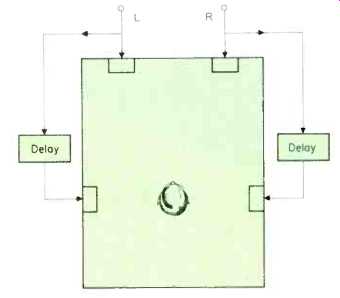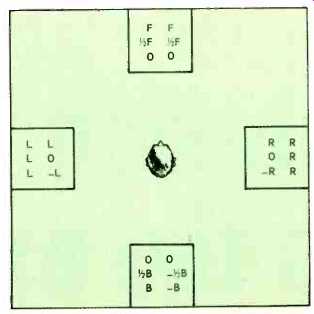by Duane H. Cooper [ Univ. of Illinois, Urbana, Ill. 61801.]
THE TRIPHONIC system, which I described recently (AUDIO, p. 36, Nov., 1970), was one which had been stripped to its psycho-acoustic fundamentals. For the sake of clarity, mention of possible refinements and extensions had been omitted. However, this system does share with other stereo systems using widely-spaced speakers a problem that may be designated as sound-image polarization-the old hole-in-the-middle problem. Here, this problem is that of an instability, against varying listening positions, of images along the front-to-side axes.
A smoother frontal spread is obtained if the front speaker by replaced by a spaced pair of speakers, each carrying the sum signal. For example, an existing stereo pair, mono connected, may be used with minimal modification of an operating installation. Many experimenters will prefer this quadraphonic array using what may be called "split" front speakers. The reproduction should still be regarded as triphonic, however, since the two front speakers still carry the same information.
With existing recordings, the smoothing benefits of split front speakers are easy to demonstrate. Whether splitting the side speakers will produce similar benefits is a question not so easily settled, since commercial recordings designed to exploit triphonic reproduction for side and back localizations are not, of course, available. Any such splitting should be designed, however, to make the most effective use of the greater psychoacoustic weight attaching to the side locations.

Fig. 1--The triphonic system explained by Cooper in his earlier article.

Fig. 2--One possible quadraphonic speaker arrangement.
For example, the left side speaker could be moved forward somewhat to take the 0 degree position (Fig. 1), and a speaker in the extreme left-back position could be added to carry an L-R signal. The corresponding provisions would be made on the right, but with the extreme right-back speaker to carry an R-L signal. Thus the off-center bias in back localization which I earlier noted as being a hazard for a single difference-connected back speaker would be avoided. It is this use of such difference-connected speakers that would merit further study in schemes that are basically triphonic.
A matrix-like array may be used to indicate the speaker locations and signal combinations described above, as follows:
F F
L R
B -B
in which F stands for L+R. and B stands for L-R. Then, with R = O. L = R, L = -R, and L = O. the arrays obtained are shown in Fig. 2. In-between combinations are clearly possible.
Microphone arrangements and their matrix combinations to obtain specific localizations other than these are not obvious in every instance. Further experimental data, whereby the psycho acoustic weight of the side-speaker locations may be determined, are needed. It will be recalled that it is this weight that would make it possible to obtain a subjective impression of excellent channel separation in the face of rather little electrical separation. Thus, automatic circuitry to detect level balances and to steer these to effect an enhancement of subjective separation would not be needed.
(adapted from Audio magazine, Feb. 1971)
Also see:
How Many Channels--part 1 (Nov. 1970)
Omnidirectional Radiation (in Acoustics) (Mar. 1973)
Quadraphony Needs Directional Loudspeakers (Mar. 1973)
= = = =